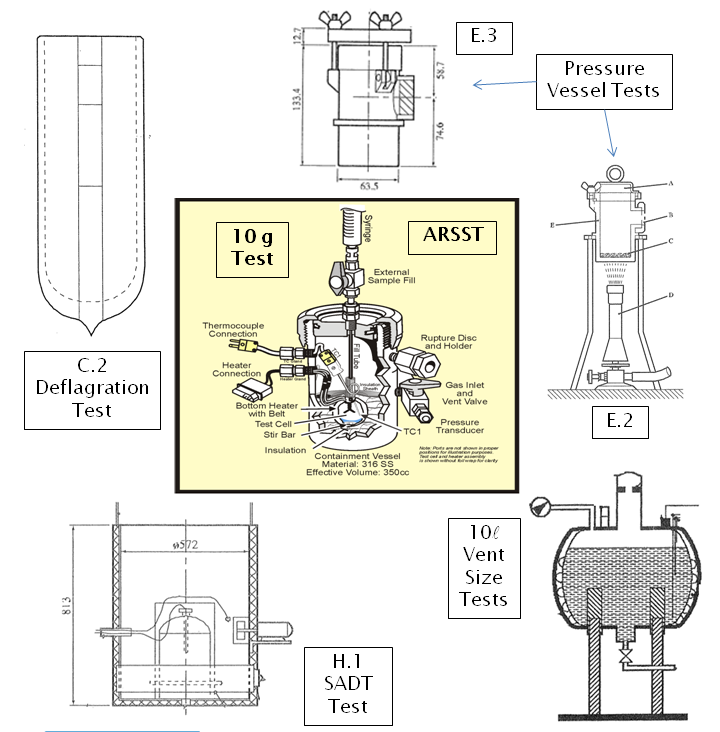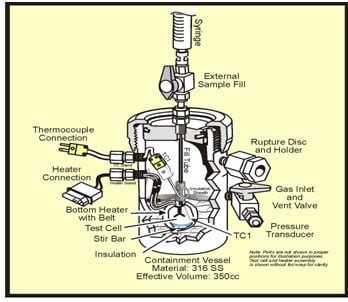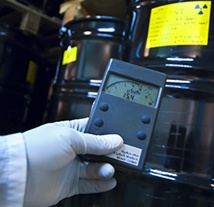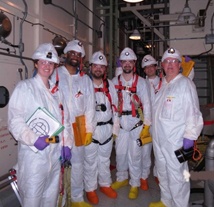Hans K. Fauske, D.Sc., Regent Advisor, Fauske & Associates, LLC (FAI) recently presented "AN ALTERNATIVE METHODOLOGY ADDRESSING UNITED NATIONS' (UN) GUIDELINES FOR SELF-REACTIVE SUBSTANCES THE EASY AND VERIFIED WAY". His findings and recommendations, are highlighted below.
A simple ARSSTTM*** test (~ 10 ml sample) can serve as an alternative method to:
- The multiple UN 10L tests - Relief Sizing (FAI's Process Safety News, Fall 2012, Vol. 19, No. 4)
- The UN full scale commercial package H.1 test -SADT Determination (FAI's Process Safety News, Spring 2013, Vol. 20, No. 2)
- The multiple UN tests - Packaging Classification Type A to G Determination (FAI's Process Safety News, Fall 2013, Vol. 20, No. 4)

The proposed Alternative Methodology is consistent with UN guidelines which allow other procedures to be used provided that adequate correlation has been obtained with the classification tests on a representative range of substances.
Not that we need another acronym, but the general term SART can represent the specific term SADT (Self-Accelerating Decomposition Temperature) commonly also applied to self-reactive systems that do not exhibit decomposition such as polymerization reactions etc.
Adopting the general term SART has the benefit of minimizing confusion. In the absence of decomposition, such substances need not be treated as UN Division 4.1 self-reactive systems evaluated under the specified test regimes.
A single ARSST test can determine the SART value and serve as an alternative method to the UN full scale commercial package H.1 – SADT determination as well as determine the presence or absence of decomposition reaction. In the presence of decomposition reaction the single ARSST test can also serve as an alternative method to the Multiple U.N. Tests for Division 4.1 (self-reactive systems) or Division 5.2 (Organic peroxides) addressing packaging classification type A to G determination (Process Safety News, Fall 2013, Vol. 20, No. 4).

Finally, it is noted that the single ARSST test can also serve as an alternative method to the multiple UN 10 l tests – Pressure Relief Sizing (FAI's Process Safety News, Fall 2012, Vol. 19, No. 4). The proposed Alternative Methodology is consistent with UN guidelines which allow other procedures to be used provided that adequate correlation has been obtained with the classification tests on a representative range of substances.
This is The Case
***What is the ARSST TM?
Background
The Advanced Reactive System Screening Tool TM (ARSST TM) is a low thermal inertia calorimeter used to obtain critical upset process design data, developed by Fauske & Associates, LLC (FAI). FAI offers the ARSST along with options for customization such as a high-pressure vessel and flow regime detector, as well as commonly used items such as test cells, heaters, glands and thermocouples. FAI not only utilizes the ARSST in our fully equipped hazards laboratory but we also manufacture and sell the calorimeter for use by our clients.
The ARSST is based on DIERS two-phase methodology which is recognized by OSHA as an example of good engineering practice. This easy-to-use device is also capable of generating low phi-factor data for DIERS vent sizing and is an excellent tool for industry as well as any university engineering lab for research or unit operation studies.
ARSST tests are used to model such upset scenarios as loss of cooling, loss of stirring, mischarge of reagents, mass-loaded upset, batch contamination and fire exposure heating. This easy to use and cost-effective calorimeter can quickly and safely identify potential reactive chemical hazards in the process industry. ARSST data yields critical experimental knowledge of the rates of temperature and pressure rise during a runaway reaction, thereby providing reliable energy and gas release rates which can be applied directly to full scale process conditions.
The ARSST typically utilizes a sample size of 5-10 grams in a lightweight glass test cell with a volume of approximately 10 ml. The test cell is outfitted with a belt heater (used to heat the sample through a preprogrammed temperature scan) and then installed in 350 ml containment vessel. Tests are typically run using open test cell methodology. In this test configuration, the test cell is vented to the containment vessel. Volatilization of the test sample is prevented by imposing an inert backpressure on the containment vessel.
Benefits
The ARSST enables users to quickly obtain reliable adiabatic data which can be used for a variety of safety applications including characterization of material compatibility, thermal stability and reaction chemistry. Test data includes adiabatic rates of temperature and pressure change which, due to the low thermal inertia, can be directly applied to process scale to determine relief vent sizes, quench tank designs and other relief system design parameters related to process safety management.
Features
-
User friendly
-
Easy setup for fast test turnaround
-
Quickly screen new and existing processes for thermal hazards
-
Scanning and isothermal modes
-
Reliable results for thermal hazard assessment
-
Open or closed cell testing (obtain vapor pressure data from closed cell testing)
-
Small sample size
-
Lightweight glass test cell with good mixing
-
Compatible with Flow Regime Detector (FRED) equipment for vent sizing applications (FRED distinguishes between foamy and non-foamy behavior)
Applications
-
Obtain complete chemical systems data:
- Critical temperature
- Kinetic parameters
-
Estimate process safety parameters including:
- Onset temperature
- Temperature & pressure rise rates
- Adiabatic temperature rise
- Heat of reaction and mixing
- Tempering temperature
- Time to maximum rate (tmr)
- Self-accelerating decomposition temperature (SADT)
-
Vent sizing
-
Emergency relief system design
-
Accommodates handling of energetics and pyrotechnics










